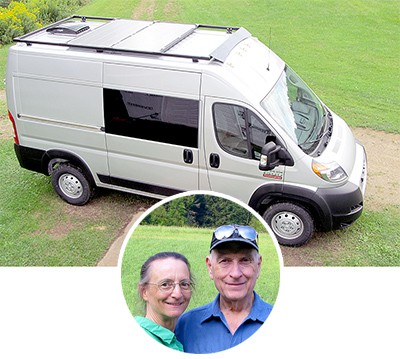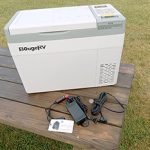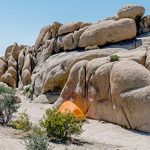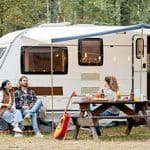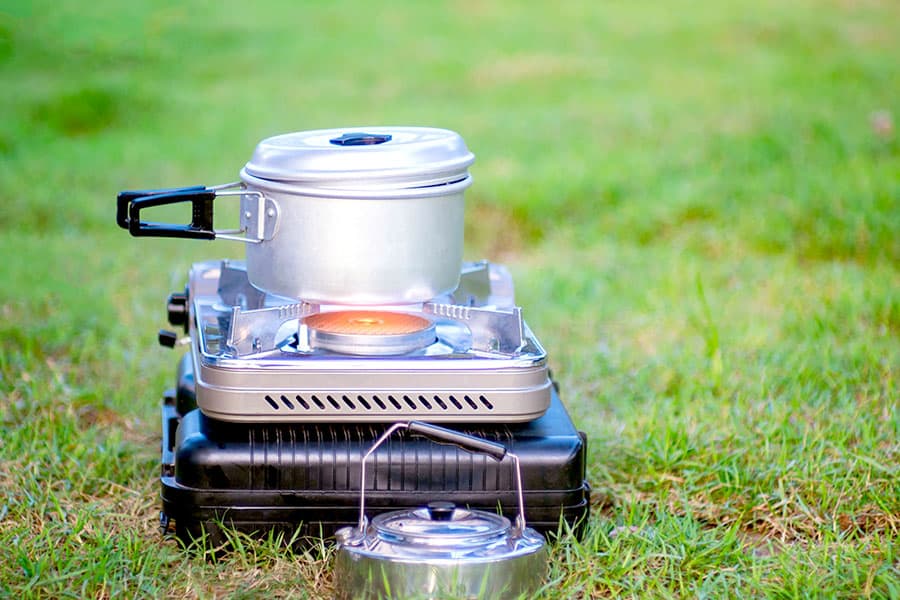
You’ve seen the commercials. There are a group of friends laughing and smiling, gathered around a campfire with their tents, vans, and other RVs behind them. They are having a great time making incredible memories. You’ve decided it’s time to join that community and to live the camping life. You know that you want to be able to cook on a camp stove — yeah, that sounds great! But now you’ve realized you have questions about that camp stove.
Do you need a regulator for a camping stove? The easy answer is yes. The complete answer is more about whether your camping stove has a built-in regulator, or if you need to add one. Regulators tend to be specific to the model of stove and type of fuel, so this is not something to which you can take a one-size-fits-all approach.
As you get ready for your camping trip, this post will discuss the different types of fuel that you can use with various types of camp stoves, as well as some of the available camp stoves.
When are Regulators Needed on Stoves?
A regulator makes sure that the amount of fuel matches the need. Another way of saying it is that the regulator’s job is to reduce the high-pressure of the gas as it exits the tank to a level that matches what the appliance needs to use. Without the regulator, the flame would be too high and would be difficult to use.
It may give you a better understanding to think of it when you consider the cooktop in your home. The knobs control the overall burner temperature and determine whether it’s searing hot or just warm. The regulator takes the first step to being able to control the amount of heat your camp stove puts out.
If you already have a camp stove, your best bet on determining whether or not you need to add a regulator to your fuel source is to read your owner’s manual. Another way to get an accurate answer is to call the camp stove manufacturer’s helpline or visit their Frequently Asked Questions on their website.
If you don’t have a camp stove yet, the next step is to explore some of the different types of fuel that various models use.
Types of Fuel
There are three standard types of fuel used with camp stoves:
1. Propane
Propane is the easiest fuel to use and the most common. Most camp stoves will accept fuel from a variety of different sized tanks. Some of the smaller propane tanks already have a regulator built into them. Larger propane tanks typically do not include a regulator.
2. Liquid Fuel
Some people prefer to use white gas as a means of fuel. A few things to consider about this:
- Is your camp stove designed to use liquid fuel?
- Liquid fuel requires you to prime the burner. Priming means that you must first release a small amount into the burner and ignite it so the flame will convert the liquid gas that flows from the container into a gaseous form.
- Liquid fuel tends to be heavier than other types of fuel.
3. Wood or Wood Pellets
Camp stoves that use wood or wood pellets are typically a grate over an open flame. If this is the type of cooking you’re looking for, these tend to be the easiest to carry because they fold down, and you can usually get your fuel wherever you are camping in the backwoods. Campgrounds also often have firewood you can buy for your campfire and camp stove.
Decisions to Make About Your Camp Stove
In addition to deciding what type of fuel your camp stove will use, you also will want to think about some of the following features for your camp stove:
Do you want a simple canister burner? These are the camp stove burners that sit directly on top of the canister of fuel and provide an unsheltered flame. They tend to be small and have a single burner.
Have you considered making sure your camp stove has wind shields on three sides? No, these aren’t the clear windows on the front of your van. These are made of the same material as the camp stove base and shield your flame from wind.
Speaking of the flame, how many burners do you want your camp stove to have? Are you planning on using multiple burners to make eggs and pancakes or hash browns and turkey bacon at the same time?
Where are you going to set your camp stove? Are you going to place it on a tabletop, or will it have legs so it can stand alone? One thing to think about is that if you are going to choose a camp stove with legs, make sure the legs are adjustable so you can account for the uneven ground.
Here are some other great posts for you to read related to this topic:
- How To Clean Your Camping Stove And Burners: 16 Tips That Work
- Camping Gas vs. LPG: Is There A Difference?
- Are Camping Fridges Worth It? These Ones Are!
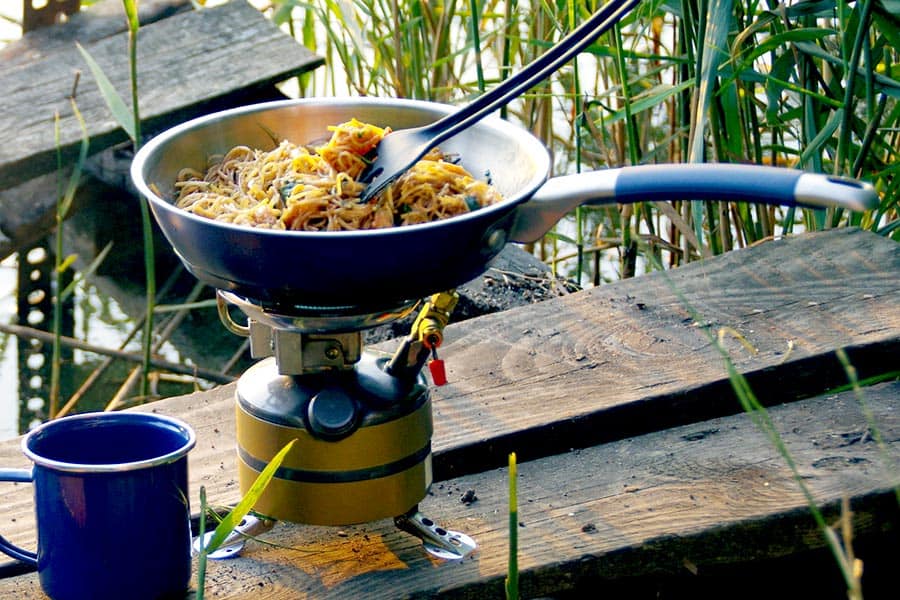
Camp Stoves for Each Fuel Type
If you’re taking your van to a campground or driving directly to your camping spot out in nature, then the weight associated with your camp stove is probably not as much of a concern as it would be if you were backpacking. When cooking right at your camping location is where the propane, liquid-gas, and wood fuel camp stoves come into play.
1. Propane Fuel Camp Stoves
Here is a variety of propane camping stoves. On this list, you can find everything from the open burner that sits directly on top of the bottle of fuel to a gourmet three-burner stove with temperature control.
Coleman Portable Bottle Top Propane Gas Stove with Adjustable Burner
Willor Portable Camping Stove – Lightweight Windproof Backpacking Outdoor Camp Stove
STANSPORT – Single Burner Propane Burner Camping Stove
Outbound Camping Stove – Portable Propane Gas Stove with 2 Burners
Blackstone Single Burner Camp Stove – Portable – Adjustable Legs for Uneven Terrain
Coleman Stove Propane Fyre Captain 2-Burner
Camp Chef PRO90X Three Burner Camp Stove
2. Liquid Fuel Camp Stoves
As discussed earlier, the propane camp stoves are the most common, so there are fewer options listed for the liquid fuel stoves, but here are some that vary from the bottle-top version to a multi-burner option.
Coleman Camping Stove – Dual Fuel Stove
Coleman 2-Burner Dual Fuel Compact Liquid Fuel Stove
nCamp Kitchen to Go Plus, Portable Compact Multi-Fuel Burning Camping Stove
3. Wood Fuel Camp Stoves
Wood-burning camp stoves do not need fuel regulators. The main thing to think about when using a wood-burning camp stove is that you will need to be patient. Your flame will need to die down some before you want to cook most foods. Once you master this cooking style, nothing will hold you back from any environment.
TOMSHOO Camping Stove Camp Wood Stove – Foldable
UCO Flatpack Portable Stainless-Steel Grill and Fire Pit
Solo Stove Compact Wood Burning Camp Stove
But if I Need to, Is It Hard to Add a Regulator to My Propane Tank?
Adding a regulator is something you can definitely do without breaking a sweat.
Just remember that regulators are not interchangeable between fuel sources. And most of the smaller fuel sources already come with a built-in regulator. With that in mind, this will focus on the 20-pound (also referred to as a 5-gallon) propane tank.
How to Add a Regulator to Your Full-Size Propane Tank
You already know that your camp stove’s user manual will provide you with the vital information you need as to whether or not you need to add a regulator to your fuel source. Here’s what to do if it’s necessary:
- Know what type of propane tank you have. The tank type will determine what size fitting your tank needs.
- Make sure the hose you are going to use is long enough to get from your tank to your camp stove.
- Leaving the gas OFF, secure the regulator nozzle to the fitting on your propane tank.
- Attach one end of the hose to the nozzle on the regulator that is attached to your propane tank.
- Attach the other end to your camp stove.
- Turn the gas on for a moment and then turn it back off. Now lightly spray the hose connections with a water and soap combination. If you get bubbles, you know you have a leak and need to tighten your hose or regulator connections. If there aren’t bubbles, you’re all set.
As you can see, there are options to choose from where the regulator is already in place or options like wood that don’t even require a regulator. But if you need a regulator, it isn’t that hard to connect one up.
Now that you’re ready to cook, you’re going to be able to fix fast and delicious meals even though you don’t have the convenience of your stove at home. Whether you’re going to make burgers and hot dogs, just warm up some canned items, or if you’re going to make pancakes that are the envy of everyone around, nobody will go hungry on your camping adventure.


